
Free Practices Analysis - Saudi Arabian GP: once again Max is on top. What to expect from Ferrari?
With the artificial lighting system of the Jeddah Corniche Circuit turning off, the first day of activity on the track ends. The first two free practice sessions of the Saudi Arabian GP confirm, beyond the mere laptimes, an absolute domination for Red Bull, with Max Verstappen always able to keep behind a still quick Sergio Perez, and a large (and compact) group of pursuers, led by a great Fernando Alonso.
The laptimes obtained by the two Ferrari drivers, on the other hand, are as indecipherable as the free practice sessions of the last Grand Prix in Bahrain: it seems that the strategy of the Maranello team, in this 2023, is to evaluate the power deployment levels to be decided for the qualifying and the race using the two Haas as a reference (with Hulkenberg 8th able to beat the best personal laptimes of Leclerc 9th and Sainz 10th).
🏁 FP2 CLASSIFICATION 🏁
— Formula 1 (@F1) March 17, 2023
Max, Fernando and Checo in the Top 3 💪#SaudiArabianGP #F1 pic.twitter.com/RGz6yYXrDZ
Let's analyze in depth what happened in FP1 and - above all - FP2, with the help of telemetry data.
Mini-race simulation at the end of FP1 not very representative…
As we know, the tracks where night races are held do present environmental conditions that often make some sessions practically meaningless: the first session on Friday, as well as the third session scheduled for 2.30 pm (CET) on Saturday, sees a track with much higher temperatures than what the drivers will find in the race, so the same teams invest little time and few resources in trying to fine-tune the single-seaters according to these environmental conditions.
From this point of view, it is not surprising that the race simulations often carried out at the end of FP1 have been greatly shortened by the teams, where Red Bull - to talk about top teams - has completely ignored the long runs, preferring to perform other qualifying runs.
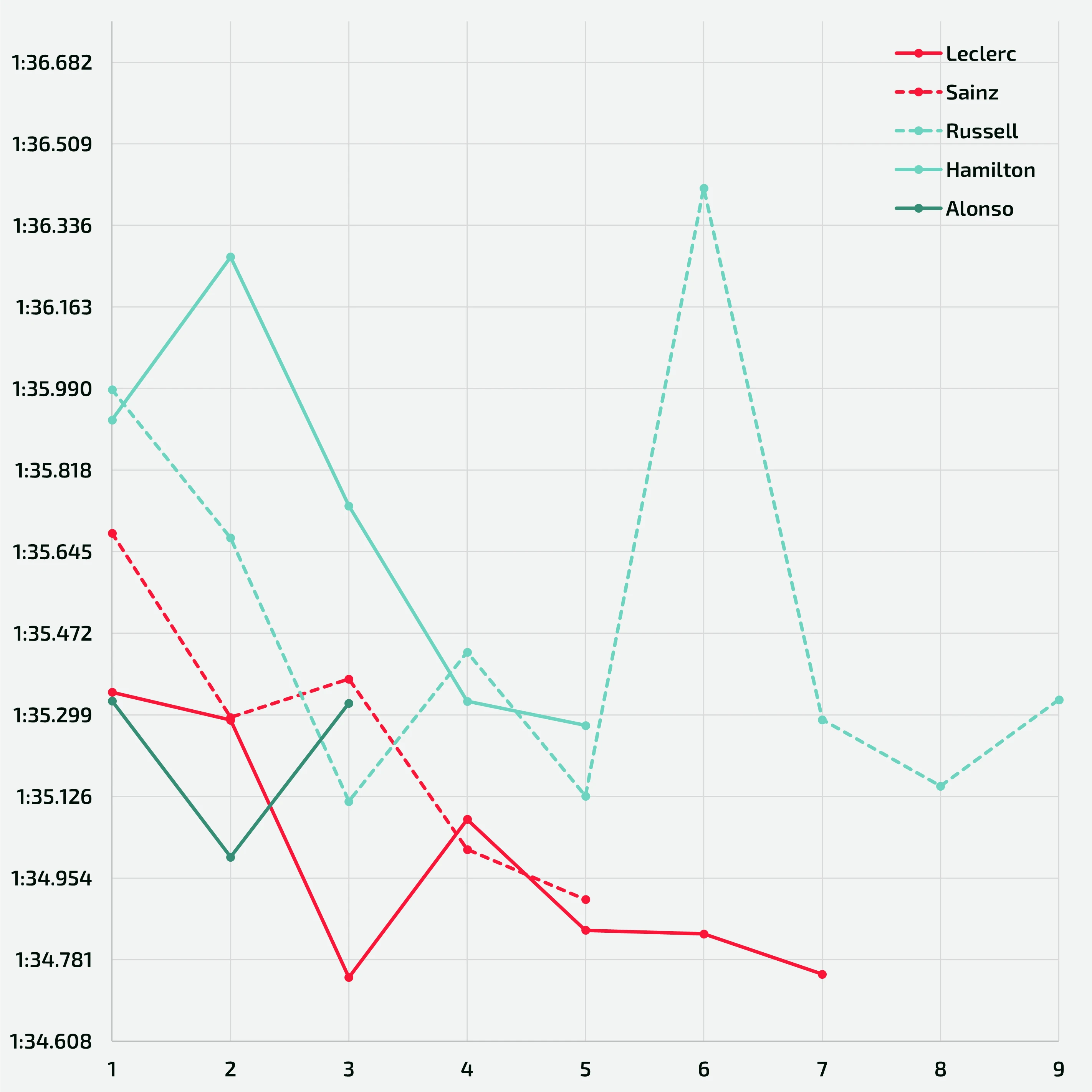
FP1 - Race simulation laptimes graph (Mercedes, Ferrari and Alonso)
Thus we are left with only the data from Mercedes and Ferrari, data which - as already mentioned - are of little significance in themselves. However, for the sake of completeness we decided to include them in this analysis: in high temperature conditions it was the SF-23 to get the better of the W14 but, as we will see when analyzing the second session outcomes, the nightfall in Saudi Arabia has brought the forces in the field closer together. For Fernando Alonso's Aston Martin, on the other hand, it's not even possible to speak of long runs, as the Spanish driver only covered 3 laps in his run - albeit with great laptimes.
FP2: Wild bunch of pursuers behind the two Red Bulls; what about Ferrari?
As anticipated, due to the environmental conditions more similar to the race, the FP2 can be considered decidedly more relevant. Both the best laptime results and the important race simulations carried out in the last 20 minutes reaffirmed the same concept: Max Verstappen is currently untouchable, and only Perez and Alonso can think about contending the second place. From the fourth time onwards, we witnessed a rather close show, with the unknown factor that Ferrari represents.

FP2 - Best absolute laptime of each driver
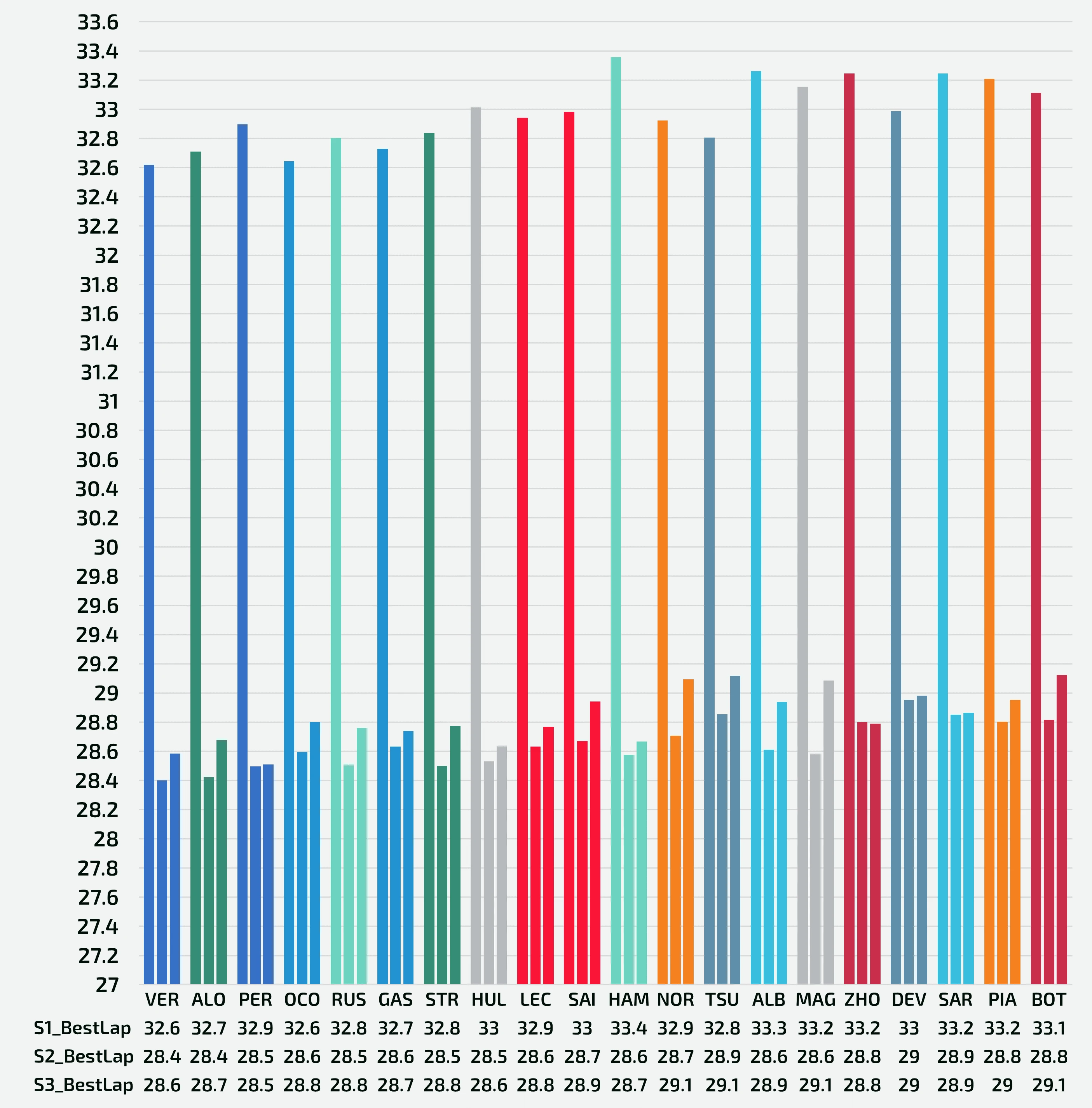
FP2 - Analysis of the split times by sector in the absolute best lap of each driver
![FP2 - Speed Trap [km/h] in the absolute best lap of each driver](/articoliImg/galleryImage1679132463-4.webp)
FP2 - Speed Trap [km/h] in the absolute best lap of each driver
The combined analysis of the split times obtained in each driver's best lap and the top speeds in the same laps allows us to draw out some conclusions about the working plans adopted by the teams.
Jeddah is in fact a circuit where having a high downforce configuration is only advantageous in the first sector, while the other two require high top speeds - and therefore a lot of aerodynamic efficiency.
In this sense, seeing the two Red Bulls with the best split times in the first sector and simultaneously capable of reaching a top speed of 331 km/h gives further evidence of their current level of competitiveness.
Motorsport Images / Glenn Dunbar
Which other teams have opted for an aerodynamically "low downforce" setup ? Surely we name Mercedes, Williams and Haas, even if the Italian-American team - as mentioned at the beginning of the article - was used as a reference in Ferrari regarding the power levels of the Power Unit, so it's possible that Hulkenberg's 331 km/h and Magnussen's 329 km/h are the result of a stronger engine mapping, rather than a low-download aero configuration.
At the opposite extreme there are the two Alpines of Ocon and Gasly, which by virtue of heavily loaded wings do not go - respectively - beyond 324 km/h and 320 km/h. Also in Alpha Tauri the speed traps on the straight are not particularly exciting, but already from the first round in Bahrain it was clear that the car of the Faenza team is not particularly brilliant in terms of absolute performance, so it is understandable that the engineers have decided to compensate for the AT04's inherent lack of downforce with heavily loaded wings. Obviously this had an impact on top speeds, never above 320 km/h: if the set-up chosen in Faenza for the race were to be the one seen in FP2, it would leave Tsunoda and De Vries quite vulnerable in the race to attacks from their opponents in long DRS zones .
Motorsport Images / Steven Tee
In this regard, Ferrari is in the middle: 327 km/h of top speed, but with the “promise” of putting more horsepower on the asphalt in qualifying and in the race.
Telemetry analysis: what are the strengths of each team?
The performance considerations just expressed are also reflected in the telemetric analysis, for which it was decided to compare the best laps of Verstappen, Alonso, Ocon, Russell, Hulkenberg and Leclerc (strictly in ranking order).

FP2 - Telemetry comparison between Verstappen, Alonso and Leclerc (speed trace, instant by instant)
From the analysis of the speed traces it emerges that Red Bull is quicker on the straights, which is nothing new compared to what has just been said. The novelty, however, lies in the performance of Fernando Alonso's Aston Martin in the acceleration phase. As can be seen, the speed trace of his AMR23 is always out of phase to the left with respect to Verstappen's RB19 and Leclerc's SF-23: this means that in the traction zones, the Spaniard has the possibility of using the horsepower of his Mercedes Power Unit more effectively than its rivals, which translates into a significant performance advantage.
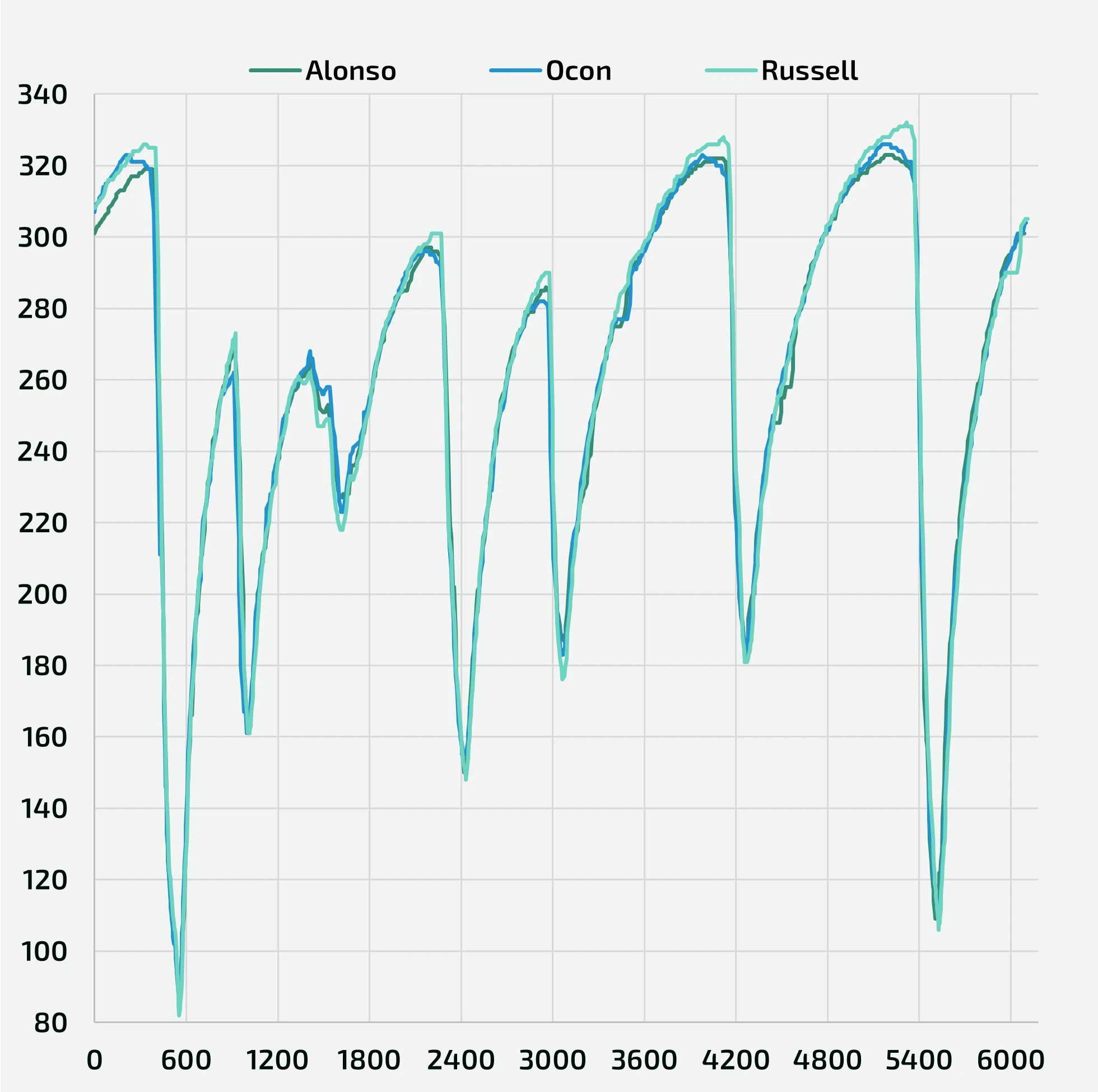
FP2 - Telemetry comparison between Alonso, Ocon and Russell (speed trace, instant by instant)
If we take Fernando Alonso's reference and overlap it with the speed traces of Ocon's Alpine A523 and Russell's Mercedes W14, we can see that the advantage just mentioned fades, especially in comparison with the works Mercedes. This suggests that the advantage in the acceleration phase is due to the particular type of power delivery by the German Power Unit, which prefers to "use" energy via MGU-K and MGU-H in the initial parts of the straights, to then accept a not so much exaggerated clipping.
By "clipping", we recall, we mean the phase in which - at the end of the straight - the extra thrust due to the electrical part of the Power Unit runs out, resulting in a speed decrease even before the braking zone. The most curious of you will remember the disappointing performance of McLaren-Honda in the three-year period 2015-2017: well, especially in the first year the clipping of the Japanese Power Unit was so exaggerated that it started before halfway down the straights!
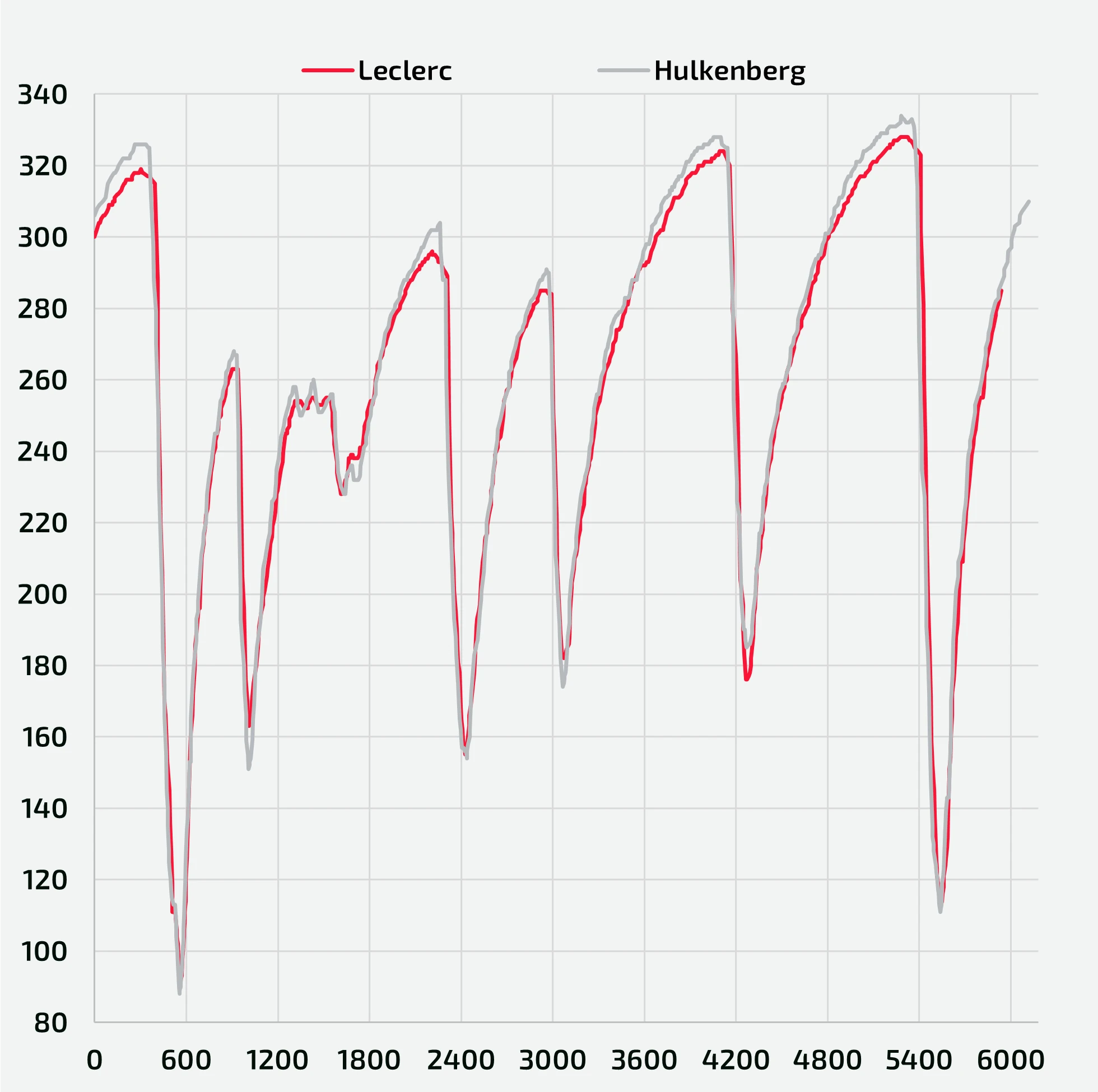
FP2 - Telemetric comparison between Hulkenberg and Leclerc (speed trace, instant by instant)
Going back to our telemetric analyses, in support of what has been said about the conservative power mode chosen on Leclerc and Sainz' Power Units, we can observe the comparison with the aforementioned Haas team: in each straight, thanks to Hulkenberg reference, we can observe what the SF-23 would be capable of.
But that's not all: telemetry also gives us useful information about the virtues and driving struggles encountered by everyone: for example, how easily does each single-seater allow you to go on the throttle?
![FP2 - Telemetric comparison between Verstappen, Alonso and Leclerc (throttle pedal position [%] instant by instant)](/articoliImg/galleryImage1679132463-8.webp)
FP2 - Telemetric comparison between Verstappen, Alonso and Leclerc (throttle pedal position [%] instant by instant)
![FP2 - Telemetry comparison between Alonso, Russell and Ocon (throttle pedal position [%] instant by instant)](/articoliImg/galleryImage1679132463-9.webp)
FP2 - Telemetry comparison between Alonso, Russell and Ocon (throttle pedal position [%] instant by instant)
In this case, the two telemetric graphs show two peculiarities, relating to Ferrari and Mercedes:
- Both cars force their drivers, Leclerc and Russell, to hesitate in some zones the first and second sectors: this is an indication of a balance that is not yet optimal, but the progressive rubbering of the track as more laps are completed could mitigate this deficit;
- The second peculiarity concerns a rather unique driving style in this "ground effect" Formula 1, that of Charles Leclerc. The Monegasque driver is the only one, in 4 of the 7 braking zones of the Jeddah circuit, who never completely takes his foot off the gas pedal, keeping a 10%-20% open. Something similar to what we saw in the past with Gilles Villeneuve, who in the first Turbo era tried to limit the inertia of the turbocharger by keeping the engine at low revs as little as possible... In today's F1 this need no longer exists, as the “turbo-lag” is minimized by the propulsive action of the MGU-K; however, it must be said that - even for a driver in the top series - it is by no means easy to adopt a driving style like the one described: for me, it is the n-th (no longer required) demonstration of Charles' driving skills;
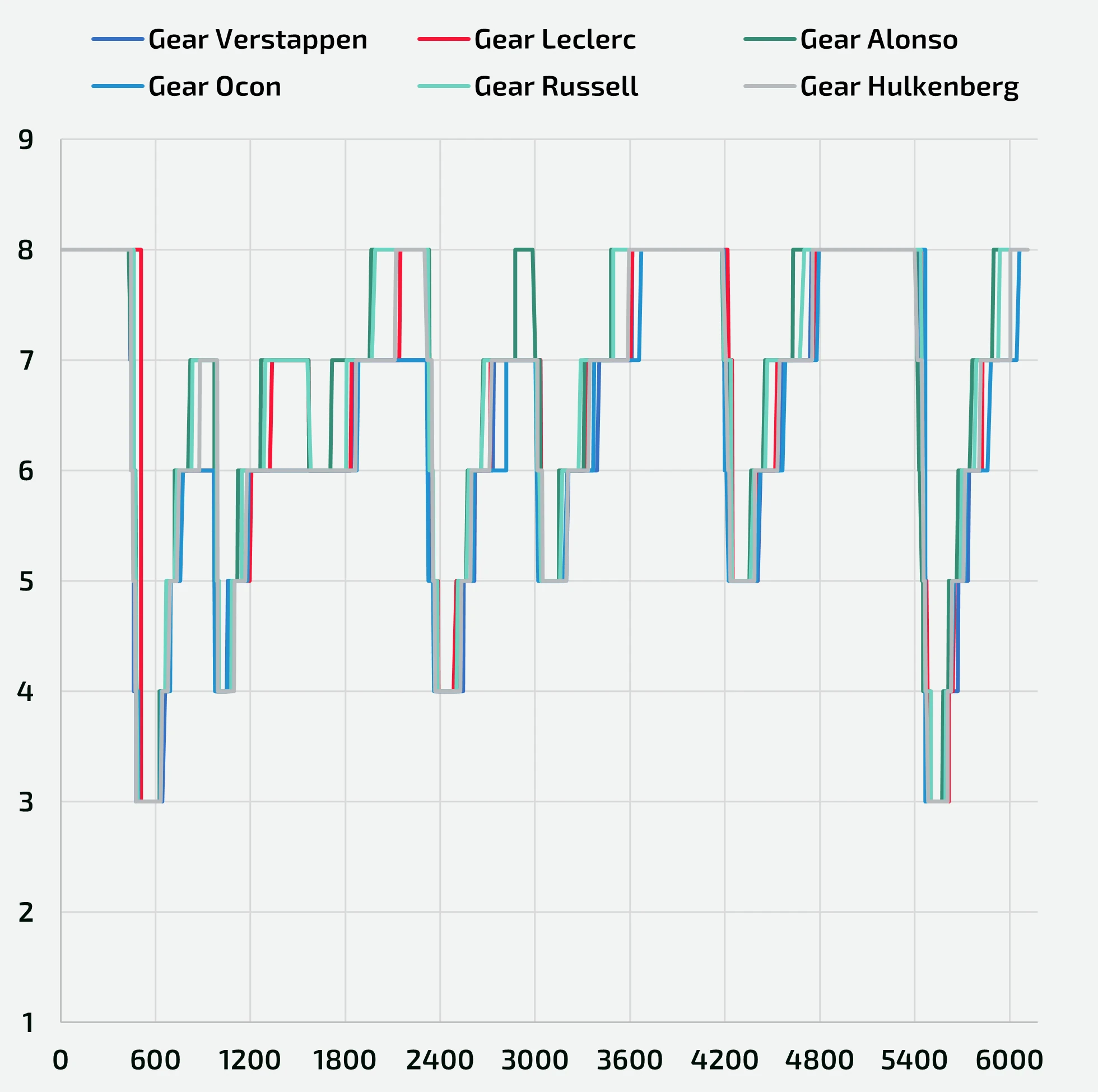
FP2 - Telemetric comparison between Verstappen, Alonso, Ocon, Russell, Hulkenberg and Leclerc (gear engaged instant by instant)
Finally, it may be interesting to include in the telemetric analysis the gear engaged instant by instant by each of the 6 drivers examined: the use of the gears was very similar for all, with the exception of what has already been highlighted for Alonso. The searing acceleration of his AMR23 allowed him to upshift faster and earlier than the others, to such an extent that he engaged eighth gear where his rivals did not go beyond seventh.
Race Simulation Analysis: who has the best chances on Sunday?
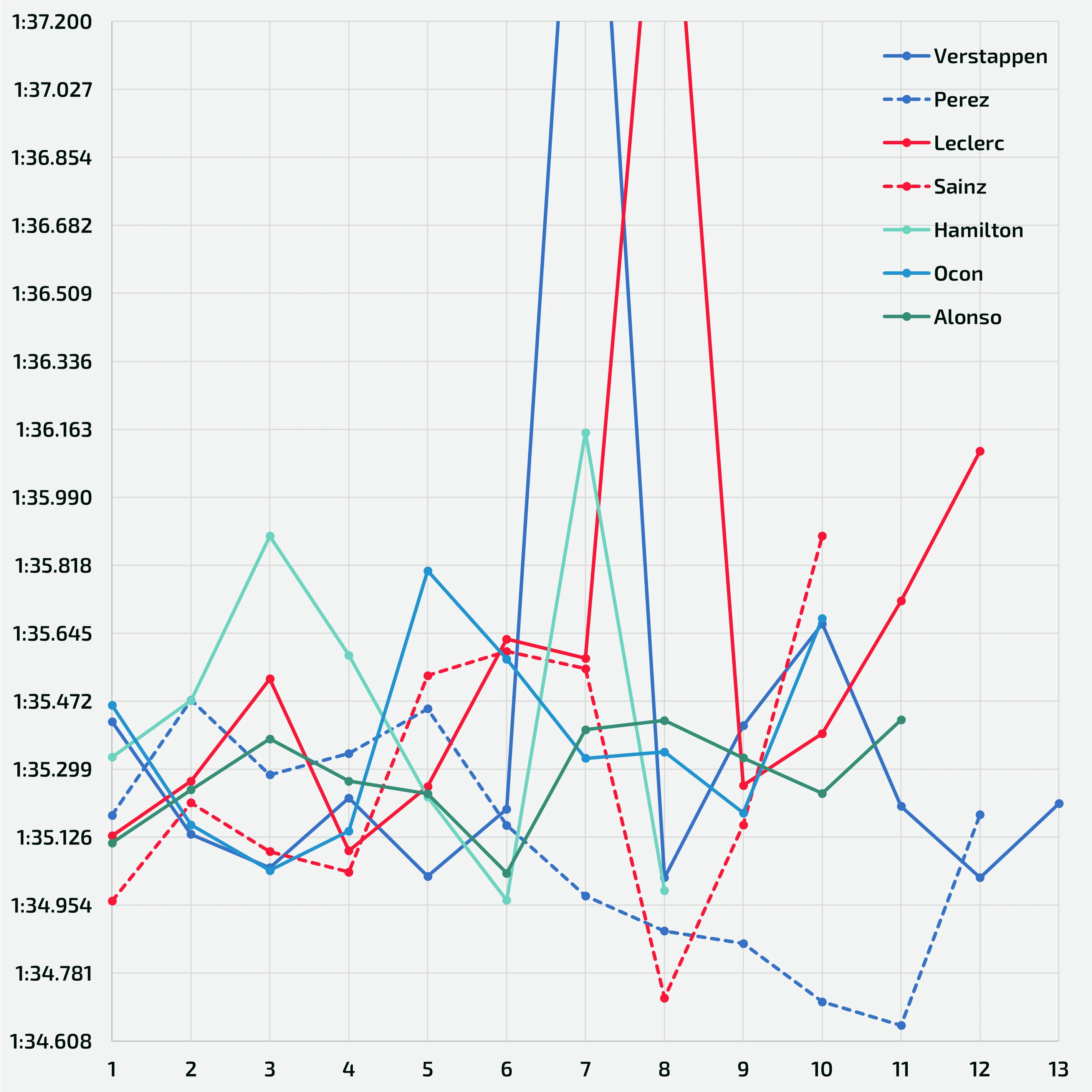
FP2 - Analysis of the race simulations carried out by Verstappen, Perez, Leclerc, Sainz, Hamilton, Ocon and Alonso
The final minutes of FP2, as usual, were dedicated to race simulations. These simulations confirmed the performance levels extrapolated from the best laps, however further highlighting the performance of Ocon and Gasly's Alpine A523. The French team's car has been a "track sensitive" car for the past couple of years, i.e. highly susceptible to the type of track it races on: in fact, there are a number of circuits on which its chassis, aerodynamics and engine qualities are exacerbated, and it is safe to say that the fast street circuit of Jeddah falls into this category.
The overall trend, having already said of the Alpine, sees as always the Red Bulls with a superior pace to the opposition: in particular, since the Jeddah circuit puts much less stress on the tyres than the Bahrain International Circuit, it is even more astonishing the negative deg showed by Perez (on mediums) and Verstappen (on softs).
The sore point comes from Ferrari: the performance drop caused by tyre wear has not yet been overcome, as shown by the long runs of Leclerc (who only ran on medium tyres) and Sainz (who tested softs and a couple of laps on medium tyres). From a racing perspective, this could force the two Prancing Horse riders to choose harder compounds, reluctantly giving up the performance advantage guaranteed by the (less durable) softs.
What to expect from the qualifications?
The pole position (qualifying at 18.00 CET) seems to be a prerogative of Max Verstappen. Behind him I predict - as already anticipated - a fight between Alonso and Perez, where the former will have to put his all into it to execute a better lap than a superior Red Bull. From fourth place onwards, every prediction seems like a gamble, so - being in the field of hypothesis - I would say that Charles Leclerc could show once again his skills as a "qualifier" . But remember this: the Monegasque driver will have to serve 10 penalty positions on the grid due to the replacement of the control electronic (CE), which suggests a comeback in the race, where he will have to keep away from the dangers of the ever nearby walls of Jeddah.
Index
Free Practices Analysis - Saudi Arabian GP: once again Max is on top. What to expect from Ferrari?